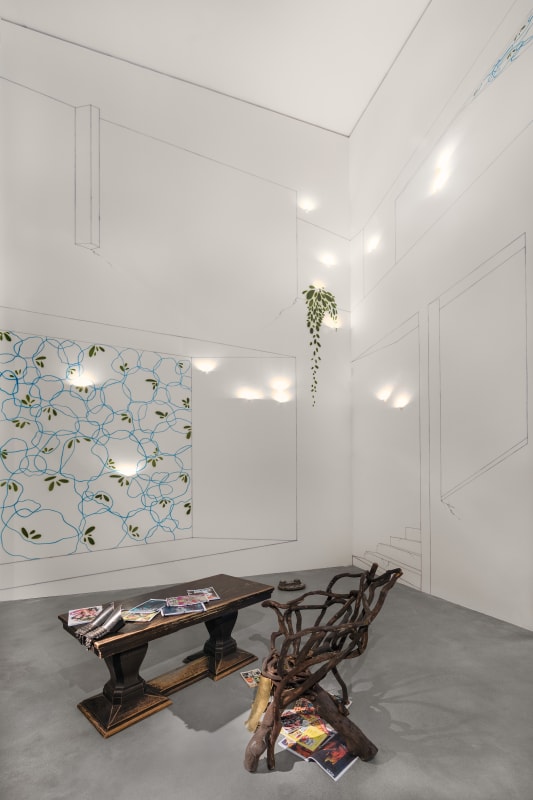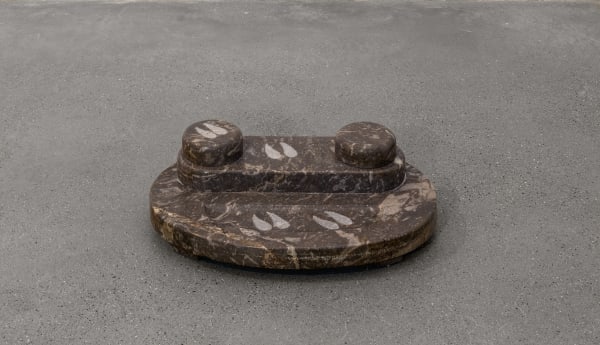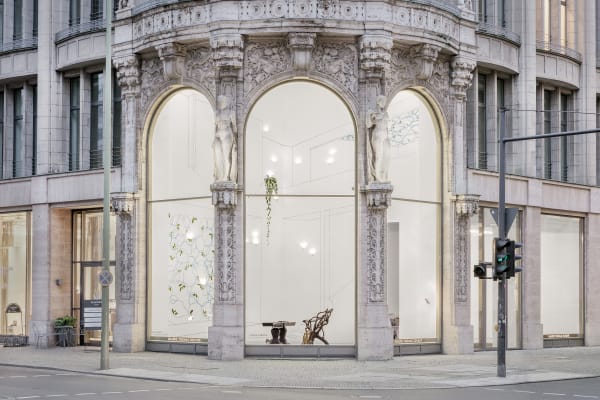WOMAN OBSERVING THE ALPHA PERSEI CLUSTER: MARIA LOBODA
-
Introduction
Galerie Thomas Schulte is pleased to present Woman observing the Alpha Persei Cluster, Maria Loboda’s first exhibition project with the gallery. In her site-specific installation, Loboda responds to the spatial parameters of the exhibition space and its history. Drawing inspiration from the findings of an ancient Egyptian burial site, 1920s Cubist architecture, a 1970s international SciFi comic book hit and a 60 million year old gigantic stellar constellation the artist creates a multilayered, transhistorical environment in which different aspects and meanings come into view in relation to changes and shifts in perspective of visitors and passersby.
The title for Loboda’s installation is taken from a caption found underneath a photograph in a newspaper, “Woman observing…,” which inspired the artist to want to make the unknown female observer—who ambiguously can also be read as the artist herself—look or marvel at something gigantic like the Alpha Persei Cluster. This cluster of stars in the stellar constellation Perseus is between 50 and 70 million years old. The Alpha Persei, the biggest and brightest of the stars, is 56 times larger than the sun. Loboda in her installation domesticates the colossal natural phenomenon from outer space and integrates it into her large wall drawing of an architectural interior.Viewed from afar, the architectural drawing The interior, left alone, transforming itself, which has been paint brushed onto the wall, dominates the view. The drawing is based on a 1920s architectural sketch by Robert Mallet Stevens (1886-1945) and patterns of the same era by the interior designer Jacques-Émile Ruhlmann (1879-1933). Spread across the two perpendicular walls, the modernist interior becomes spatially distorted, while at the same time and in contrast to the original drawing, Loboda’s interior shows signs of abandonment and decay.
Opposite the drawing, the work Some mysteries have no clues, two stainless steel cups, which the artist had forcefully crushed, adorn the two pillars. They are influenced by the so-called Ringlemere Cup, a golden vessel from the Bronze Age found in England in 2001 that was acquired by the British Museum. The weight of the soil, which buried the cup for centuries, slowly led to its destruction and left it folded in on itself enhancing its unique beauty.
Inside her interior, Loboda presents her new work The chair of Hetepheres, Mother of Khufu. The seat, legs and backrest of the chair consist of interwoven, irregular branches. The work is a reproduction of the so-called “Naturstuhl” (nature chair) by Karl Gräser (1875-1920), who was one of the co-founders of the Monte Verità community on a hill in the Swiss canton Ticino, which in the early Twentieth century became the home for different Utopian movements and an artist colony. Loboda appropriates Gräser’s back-to-nature design and places it in the context of the history of the ancient Egyptian queen Hetepheres. Hetepheres’ funerary chamber, which was discovered in 1925, mysteriously did not contain her mummy, but several pieces of furniture, including an armchair. Her burial site was found near the great pyramid of Giza, built during the reign of her son Khufu and the oldest of the Seven Wonders of the Ancient World.
Another work decorating the space is a 1920s marble desk set bearing the traces of a deer or a gazelle. Loboda has engraved the prints of the animal’s hooves on its surface to create an artificial petrosomatoglyph, the natural shape of footprint carved into rock, whose symbolism is used in religious and secular ceremonies in many cultures around the world. The word gazelle is derived from the Arabic word ghazāl, which also describes a type of love poem, which originates in the 7th century and centers on the themes of love and separation.
In the centre of the room there is a chair and a table with medieval armored gloves and antique greaves. Next to them there are several copied comic books, for example some editions of Metal Hurlant (Heavy Metal), a comic book anthology of science fiction and horror stories, published between 1975 and 1987. During the opening, the Corner Space will become platform for a happening with the title A goon for hire, when a friend of the artist will inhabit the space, temporarily embodying both the role of the “Woman observing…” and of Hetepheres. Dressed up wearing a piece of medievalist body armor, the performer will sit in the chair, reading and enjoying the books and comics.
With her dialectical and egalitarian approach to history, Loboda creates works, which play with scale in relation to time and space, both on a physical and a mental level. Evoking ancient and mysterious histories and colossal natural phenomena and architectural sites as well as domestic and mundane scenes and narratives, the artist with her installation transforms the exhibition space into a decaying bourgeois interior, burial chamber, living room and archaeological site, oscillating between interior and exterior, nature and culture, macrocosm and microcosm. -
Works
-
Installation Views
-
Inquire about works by maria loboda

-
Artists on view








